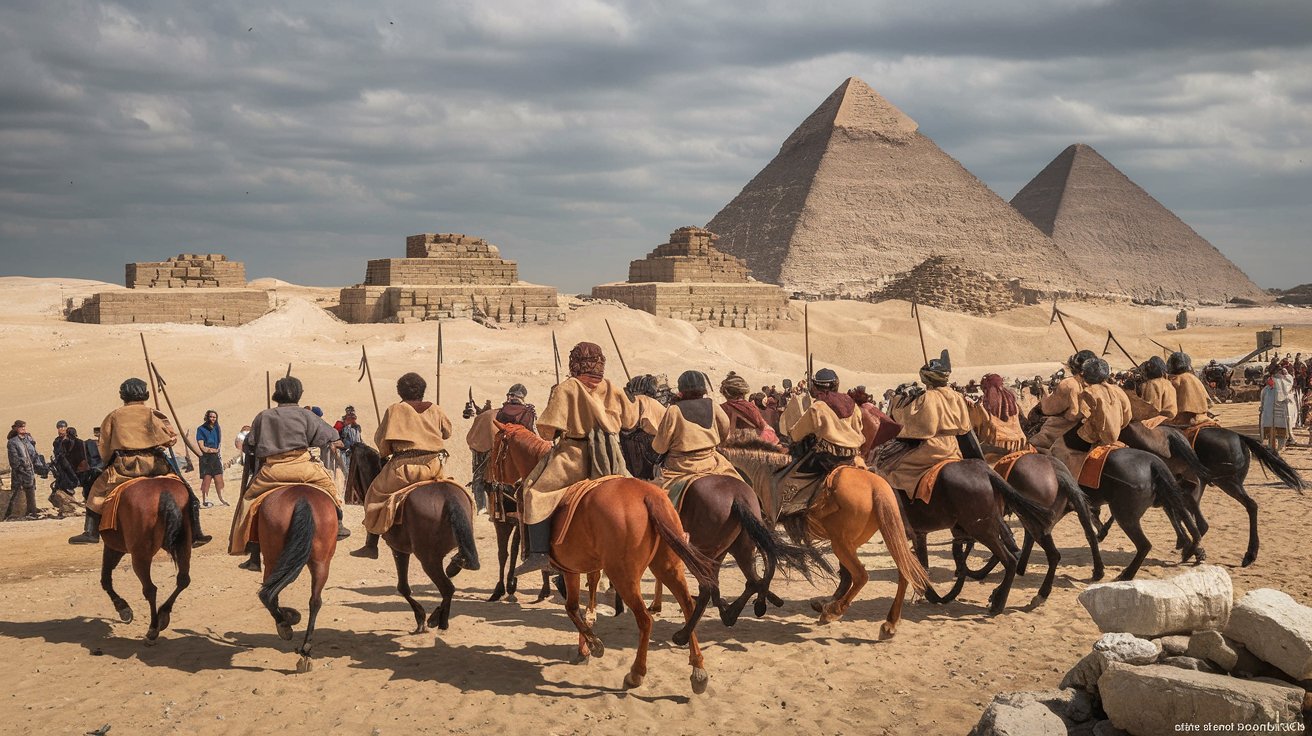
Did you know that the Nubian conquest of Egypt marked a significant turning point in ancient history? Around 730 BCE, King Piye of the Kingdom of Kush led a successful military campaign, establishing the 25th Dynasty and bringing nearly a century of Nubian rule to Egypt. This period saw a fascinating blend of Nubian and Egyptian cultures, with Nubian rulers adopting Egyptian customs while introducing their own traditions. The revival of pyramid building, the integration of Nubians into Egyptian society, and the flourishing of trade between the two regions are just a few highlights of this era. Dive into these 25 key facts to uncover the remarkable legacy of the Nubian conquest of Egypt.
Key Takeaways:
- The Nubian conquest of Egypt brought a unique blend of cultures, revived pyramid building, and showcased remarkable military prowess, leaving a lasting impact on both civilizations.
- Despite their short reign, the Nubian rulers of the 25th Dynasty left a lasting legacy in Egyptian culture through trade, cultural exchange, and the revival of pyramid building.
The Rise of the 25th Dynasty
The Nubian conquest of Egypt marked a significant shift in ancient history. The 25th Dynasty, led by Nubian rulers, brought a unique blend of cultures and traditions to Egypt. Let's dive into the key facts about this fascinating period.
-
The Rise of the 25th Dynasty: The 25th Dynasty began with King Piye's conquest of Egypt around 730 BCE. This marked the start of nearly a century of Nubian rule.
-
King Piye's Invasion: King Piye, also known as Piankhy, led a successful military campaign against a weakened Egypt. His forces captured key cities and eventually reached Memphis, the capital of Lower Egypt.
-
Egyptian Weakness: During the late 8th century BCE, Egypt was in decline. The Middle Kingdom had ended, and the Second Intermediate Period had begun, creating a power vacuum that allowed Nubia to assert its dominance.
Nubian Influence on Egyptian Culture
Nubian rulers brought their own traditions while embracing Egyptian customs. This cultural exchange left a lasting impact on both civilizations.
-
Nubian Culture and Architecture: Nubian rulers were influenced by Egyptian culture but also introduced their own architectural styles. The pyramids built during this period, such as those at Meroë, are impressive examples of Nubian architecture.
-
Pyramid Building Revival: The Nubian pharaohs revived the ancient custom of pyramid building, which had been abandoned by Egyptian pharaohs for centuries. This revival is evident in the construction of pyramids like the one built by Pharaoh Taharqa.
-
Nubian Kings as Egyptian Pharaohs: The Nubian kings of the 25th Dynasty saw themselves as renewers of ancient Egyptian glories rather than foreign conquerors. They adopted many Egyptian customs and traditions, including the use of Egyptian hieroglyphics and the construction of temples in Thebes.
Key Figures and Their Legacies
Several notable Nubian rulers left their mark on Egyptian history. Their reigns were characterized by military prowess, cultural integration, and architectural achievements.
-
King Piye's Legacy: Despite his military conquests, King Piye chose not to remain in Egypt but instead returned to Nubia. This decision symbolized his intention to rule Egypt as an Egyptian pharaoh rather than as a foreign conqueror.
-
King Shabako and Shabatka: During the 25th Dynasty, other notable Nubian pharaohs included Shabako and Shabatka. These rulers continued the policies of their predecessors, maintaining Egyptian traditions while asserting Nubian dominance.
-
Queen Amanirenas and Amanishakheto: Queen Amanirenas led her troops against the Romans, while her successor, Amanishakheto, was buried with costly grave goods. These queens played significant roles in Nubian history during this period.
Social and Military Integration
Nubians held significant positions within Egyptian society and military. This integration facilitated cultural exchange and cooperation between the two civilizations.
-
Social Status of Nubians in Egypt: During the 25th Dynasty, Nubians held positions of power within Egyptian society. Some Nubians were integrated into the Egyptian military, forming units known as the Medjay, which were renowned for their archery skills.
-
Medjay and the Egyptian Military: The Medjay were originally people from Nubia who worked as scouts and garrison troops in the Egyptian military. Over time, they evolved into a more professional police force, with some native Egyptians joining their ranks.
-
Nubian Archery Skills: The Nubians were renowned for their archery skills, earning them the nickname "Ta-Seti," or "The Land of the Bow." This skill was highly valued by both Egyptians and Nubians, who often depicted archers in their art and literature.
Trade and Economy
The Nubian conquest facilitated trade between Nubia and Egypt, enriching both regions. This period saw a flourishing exchange of goods and cultural practices.
-
Trade and Economy: The Nubian conquest of Egypt facilitated trade between the two regions. Nubia was a gateway to the riches of Africa, with goods like gold, incense, ebony, copper, ivory, and animals flowing through it.
-
Cultural Exchange: Despite their military conquest, the Nubian rulers of the 25th Dynasty engaged in significant cultural exchange with the Egyptians. This exchange is evident in the art and architecture of the period, which often blended Nubian and Egyptian styles.
-
Assimilation into Egyptian Culture: The Nubian rulers of the 25th Dynasty were deeply assimilated into Egyptian culture. They followed traditional Egyptian methods of governance and saw themselves as culturally Egyptian.
The End of the 25th Dynasty
The Nubian rule in Egypt eventually came to an end due to external invasions. However, their legacy continued to influence Egyptian culture and history.
-
End of the 25th Dynasty: The 25th Dynasty came to an end with the Assyrian invasion of Egypt in the late 7th century BCE. This invasion led to the fall of the Nubian dynasty and the return of Egyptian rule.
-
Assyrian Invasion: The Assyrian invasion of Egypt in the late 7th century BCE marked the end of Nubian rule. This invasion led to the fall of the 25th Dynasty and the return of Egyptian control.
Legacy and Archaeological Discoveries
The legacy of the 25th Dynasty is evident in the revival of pyramid building and the blending of Nubian and Egyptian styles. Archaeological discoveries continue to shed light on this remarkable period.
-
Legacy of the 25th Dynasty: Despite its short duration, the 25th Dynasty left a lasting legacy in Egyptian culture. The revival of pyramid building and the blending of Nubian and Egyptian styles in art and architecture are testaments to this period's influence.
-
Archaeological Discoveries: Archaeological discoveries have shed light on the lives of Nubian rulers during this period. Excavations at Meroë have uncovered numerous artifacts, including gold jewelry and intricate pottery.
-
Italian Tomb Robber Giuseppe Ferlini: In the 19th century, Italian tomb robber Giuseppe Ferlini looted graves in Meroë, causing significant damage to the site. However, his actions also brought attention to the mysterious culture of the Nubians, opening the eyes of European scholars to this previously unknown civilization.
Expansion and Military Prowess
Nubian rulers expanded their territory and demonstrated remarkable military prowess. Their skills in archery and strategic warfare were highly valued.
-
Nubian Territory Expansion: During the 25th Dynasty, Nubian territory expanded northwards, eventually encompassing much of the Nile Valley. This expansion was facilitated by the military prowess of Nubian rulers like King Piye.
-
Nubian Archery Skills: The Nubians were renowned for their archery skills, earning them the nickname "Ta-Seti," or "The Land of the Bow." This skill was highly valued by both Egyptians and Nubians, who often depicted archers in their art and literature.
Cultural Exchange and Cooperation
Despite periods of conflict, there was significant cultural exchange and cooperation between Nubia and Egypt. Marriages between Nubian and Egyptian royalty were common, and both cultures shared many spiritual and artistic traditions.
-
Cultural Exchange and Cooperation: Despite periods of conflict, there was significant cultural exchange and cooperation between Nubia and Egypt. Marriages between Nubian and Egyptian royalty were common, and both cultures shared many spiritual and artistic traditions.
-
Meroë as Capital: The city of Meroë became the spiritual and political capital of the Kingdom of Kush during the 25th Dynasty. It was here that many of the pyramids were built, including those at the necropolis.
-
Goldworking and Artisans: The Meroites were expert goldworkers, and their artisans produced exquisite works of art that blended Nubian and Egyptian styles. These artifacts often featured intricate designs and symbolism.
The Lasting Impact of Nubian Rule
The Nubian conquest of Egypt during the 25th Dynasty was a game-changer in ancient history. It wasn't just about military might; it was a blend of cultural exchange and political dominance. King Piye and his successors brought a fresh wave of pyramid building, art, and architecture that merged Nubian and Egyptian styles. This period saw Nubians holding significant positions in Egyptian society, from military roles to royal marriages. The Assyrian invasion eventually ended Nubian rule, but the legacy of the 25th Dynasty lived on. The revival of ancient customs and the integration of Nubian elements into Egyptian culture left an indelible mark. Despite the eventual fall, the Nubian rulers of Egypt proved that cultural and political fusion could create something truly remarkable. Their influence is still evident in the artifacts and structures that stand today.
Frequently Asked Questions
Was this page helpful?
Our commitment to delivering trustworthy and engaging content is at the heart of what we do. Each fact on our site is contributed by real users like you, bringing a wealth of diverse insights and information. To ensure the highest standards of accuracy and reliability, our dedicated editors meticulously review each submission. This process guarantees that the facts we share are not only fascinating but also credible. Trust in our commitment to quality and authenticity as you explore and learn with us.


